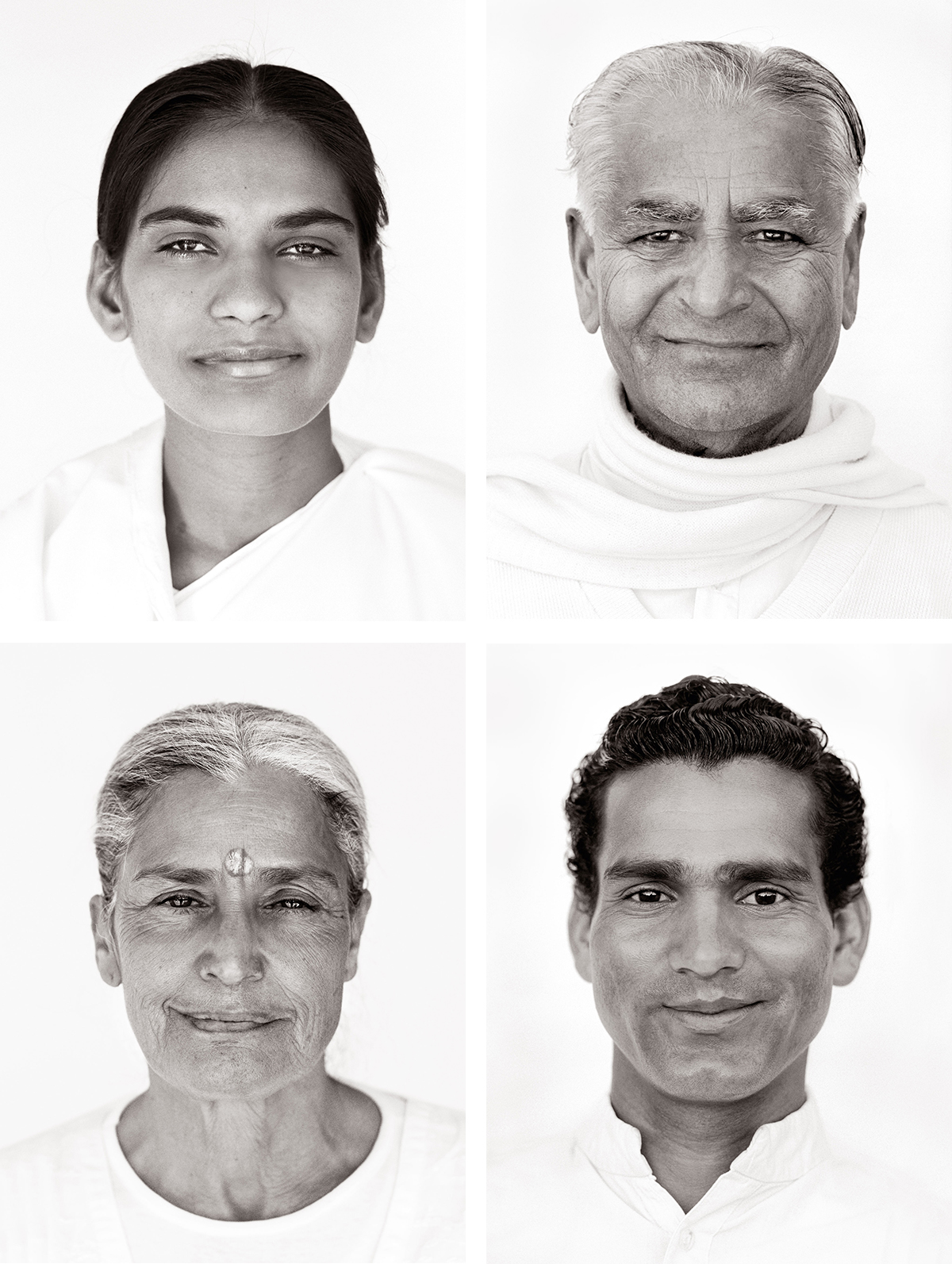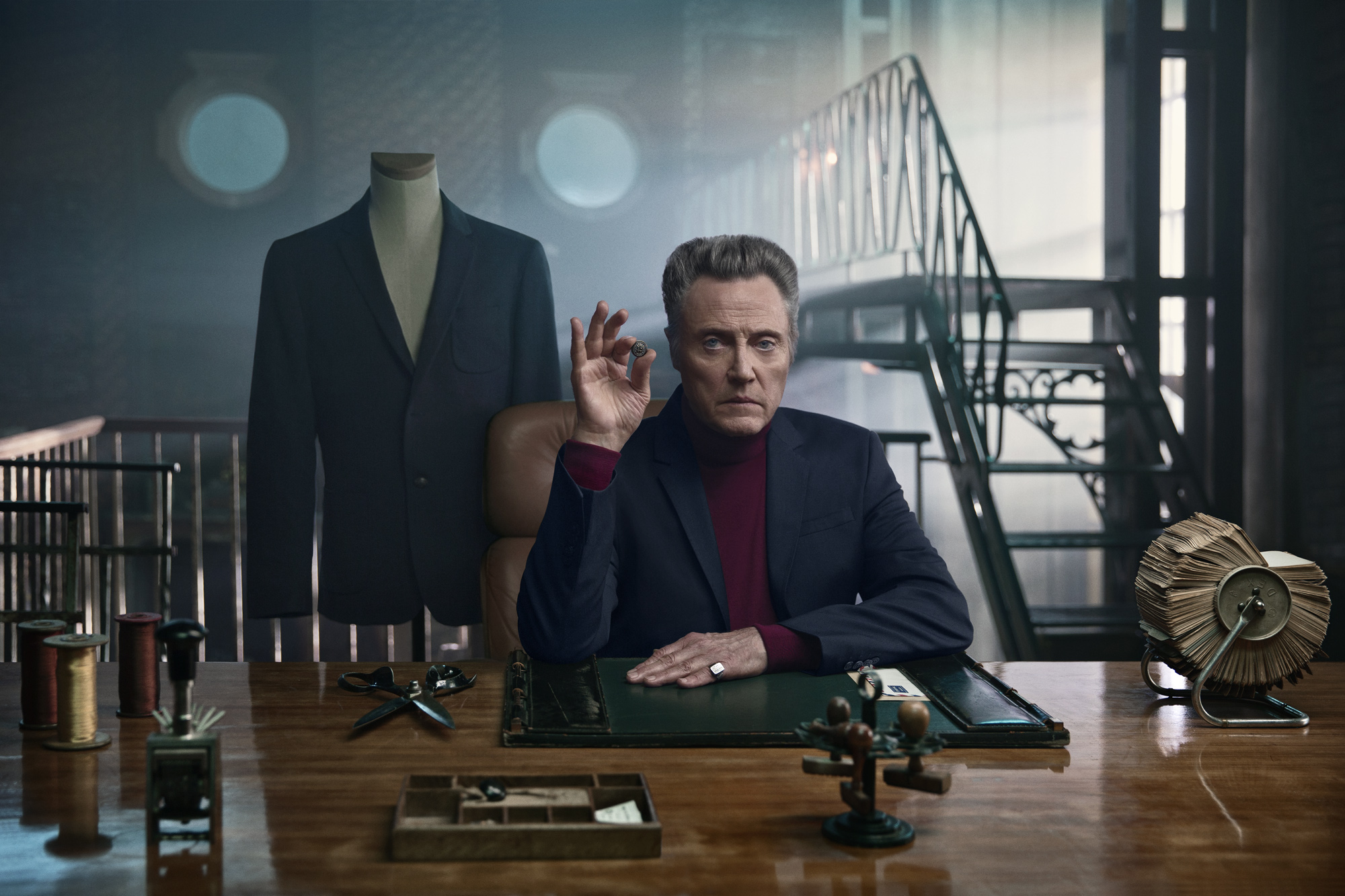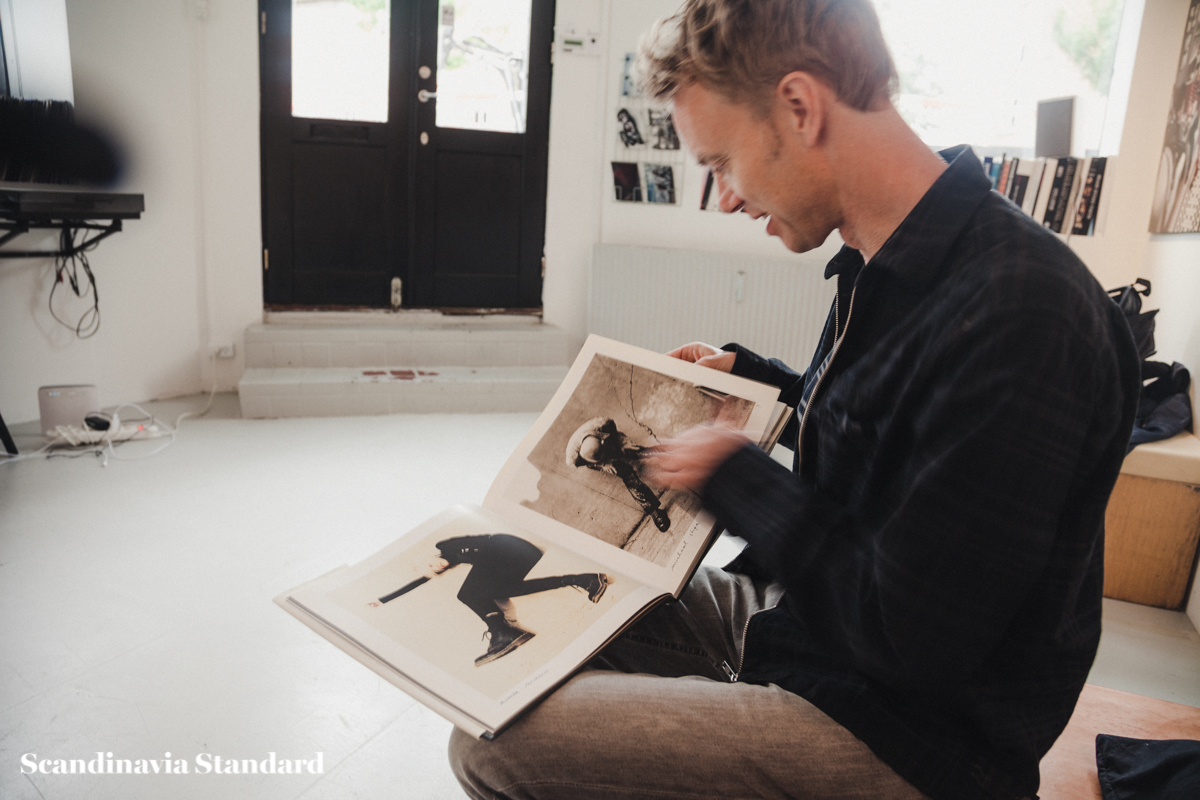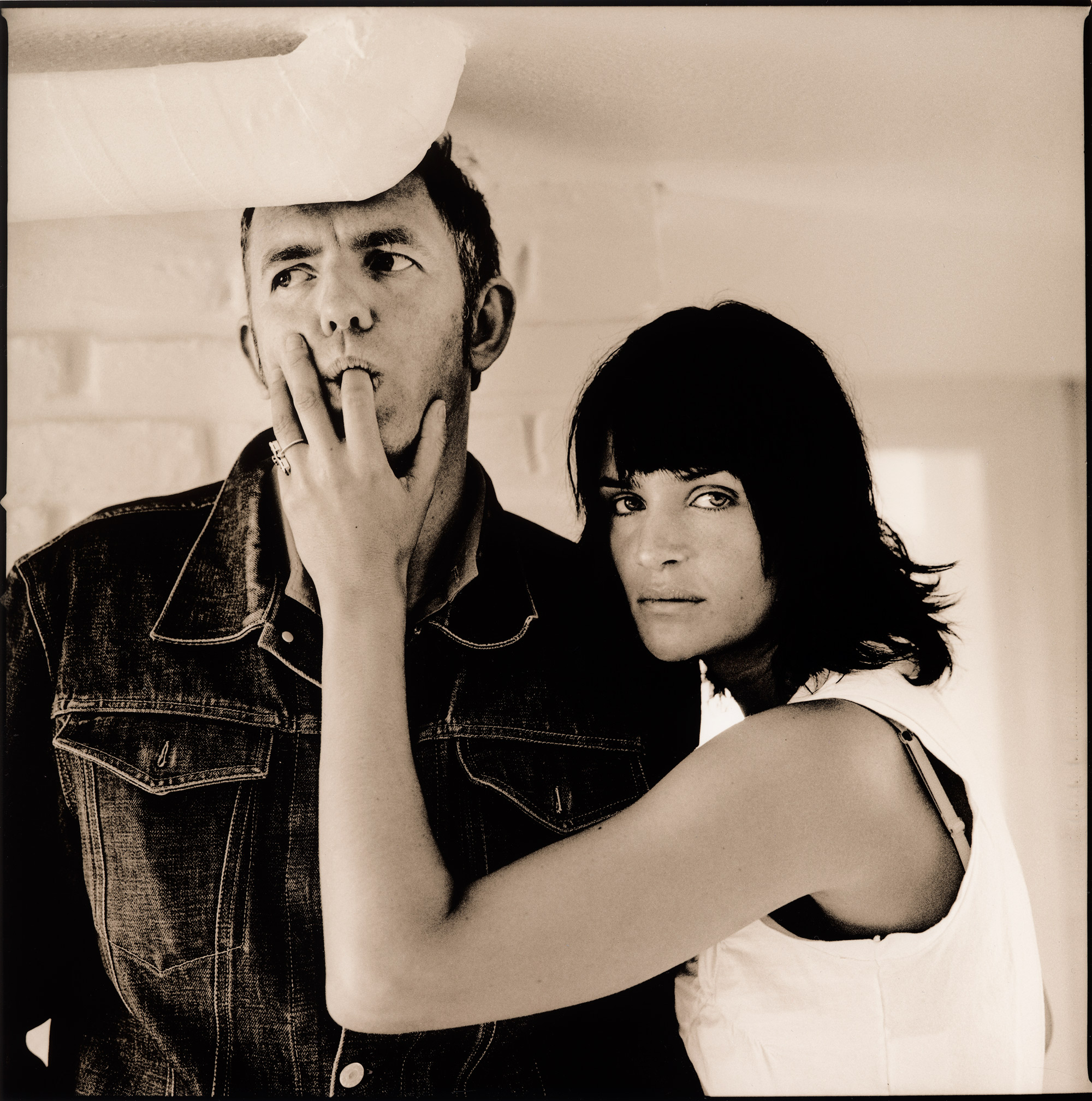While Søren Solkær is a household name for culturally-inclined Danes, foreigners are more likely to have been exposed to his photography without having known it. I first stumbled upon his portraits online. He photographed a series of yogis in mediation with their eyes open, so to make it easier to remain in a state of enlightenment even when not actively meditating. In a world of thousands of image impressions a day, these were some of the most transformative images I’ve even seen.
Later, I found myself star-struck while flipping through his earlier published work Closer, a collection of portraits spanning the world of music, film and art including Paul McCartney, Björk, Michael Douglas, U2, Samuel L. Jackson, Amy Winehouse among many others.
The subject-matter seemed like it was from an antipodal world, yet it was the same photographer. Who was this man that navigated the world of celebrity portraiture, but meanwhile created these incredibly moving spiritual images?
I sat down with Søren to try and uncover his approach to photography, exploring his vision, technique, and the story that lead him to where he is today:
Portraiture is an intimate process. What do you do to make sure you capture the essence of your subjects?
I stay pretty quiet. Portraits brought me into photography in the first place. It was a way of overcoming my own shyness.
I was young when I first started travelling. I wanted to get in touch with people and the camera became the key to doing that; the way to walk up to another human being and interact with them. A camera is a great excuse for many things.
My approach to taking portraits is like an extension of my own personality. I’ve been told very often that I’m very quiet when I take photos. I don’t scream and shout out lots of directions; it’s more of an exchange. I basically try to be present with the person and am there on an energy level rather than a directorial level.
The project that taught me the most about portraiture was one in India, where I photographed yogis in meditation. For them, it was very comfortable to be silent together. I took this idea back with me to the world of celebrity, which is kind of unusual. Basically, it’s trying to strip away vanity, and the superficial layers, and just trying to be there with another person.
In the beginning I filmed them in many different ways, and then I just found out, stripping it down to the most simple portrait is the strongest. That’s were some of that energy comes out. I did that from 1999 to 2008. A lot of my projects take close to ten years.

Souls – Rajasthan, India
Ten years ago, you created a photo series called “Inner Climate” at the Copenhagen Climate Summit (COP15), where you focused on a delegation of spiritual leaders. This is how it was explained:
“The title was drawn from an understanding that the outer climate is merely a reflection of the inner climate of humanity and that spiritual practice will affect both the people around us, and the globe we inhabit.”
I think that in the whole summer, those in the tiny little corner were the ones that nailed it. Everything else was about CO2 and quotas. These people were actually doing something, personally, to change the world.
Some of them weren’t spiritual leaders, but representatives of minorities. But I would say that they were all very spiritual. Indians from the Amazon in their full dress, and American Indian chiefs. It was a pretty wild. It was the winter time in Copenhagen, and they were walking around in their traditional dress.

Inner Climate – Copenhagen 2009
When did you begin taking photographs?
I started in 1989, when I started travelling. I grew up in the country, and I’d saved up 18,000 Danish kroner for my trip to Asia. I was 19 and it was my first time on an airplane. That was the start of a more adventurous part in my life.
I actually bought a SLR camera when I came to Singapore. I spent a quarter of my budget on a good camera. I knew that I wanted to do something with that. I’d only saved up for four or five months but I ended up staying away for a year and a half.
I met a photographer in the youth hostel in Singapore, an Australian who was a documentary photographer. I spoke to him for a while and I thought his job was the most incredible thing.

Björk – London 2007

Christopher Walken – Copenhagen 2013
Now you had a camera in your hands. What did you do next?
I travelled around South East Asia, Australia and New Zealand for a long time. I then returned to Denmark and went to university to study Nordic literature. I was mainly into poetry. I loved the poems of a Danish guy called Henrik Nordbrandt. He’s about 70 years old now. And then there’s another guy called Søren Ulrik Thomsen. Around that time, he wrote a book called City Slang. It was very 80s but I loved it. Lars H.U.G. made an album with the lyrics from that. I would just ride around on my bike with a Walkman and only listen to that (laughs). So, I was all about poetry.
There’s a lot of similarities between poetry and images. There are a lot of pictures in poetry as well. They’re condensed. I feel that analysing poetry was a very good skill to have when I started doing photography seriously. The sensibility you need to read poetry, I think that’s very helpful in creating images. Even though it’s quite different.
At university, I had access to a dark room so I learnt a lot more. Then at 24, I went travelling back to Asia, Tibet and Nepal for almost a full year to photograph. After that, I found a photography school in Prague. At that age I felt like, wow, I got a late start compared to many others. So I just gave it everything I had. Like, I just worked twenty-four seven.
When I lived in Prague, it was right after the revolution. The city was crazy, full of young people from everywhere. It was super cheap too. We were always out. I spent all my time out at night in the city and in my dark room.
So you were living in the dark, literally
Yes! The important thing for me was that Czech photography is very staged. There’s a strong theatre tradition, and that’s been incorporated into photography as well.
When I went there, I thought I was going to study documentary photography; cole-miners and that kind of stuff. But then I saw the work of some of the great Czech photographers and I changed direction.

Søren Solkær gives a tour of his photography library
I know nothing about Czech photography, except for a character from The Unbearable Lightness of Being taking photos illegally on the street
Yes, that’s the thing. When the communists came, it was illegal to photograph on the streets, and a lot of the photographers had to photograph in a room. During the whole time the communists were there, many of them worked in the same room with whatever lights they had. They would bring people in and create their own world.
That really appealed to me. I found it so fascinating to see how people got a very personal style by working within very limited parameters for many years. You knew immediately when you saw a photograph who had taken it. I thought, wow, this is great!
And then I came up with the project called “Photographers Posed,” where I started photographing photographers in this dialogue. There were photographers using their own equipment in their own studios with their own models. And printing it in the style of their own photography.
I did a very large series of pictures. First it was Danish and Czech photographers. It was like an investigation into my own background. And my new home in Prague. And then afterwards I extended it to other countries as well. So, I went to the States, Germany and Italy.
The staged quality of the Czech photography is really what I took with me from the Czech Republic. When I came back I started doing music photography and it was quite staged. That came from there.
Will we ever see “Photographers Posed?”
In the beginning of 2018, I’ll have a big exhibition at the National Portrait Gallery here in Copenhagen. It’s in a castle in Hillerød. I’m going to show 25 years of portraiture. I’ll have 12 rooms where I’ll show all my different projects including “Inner Climate,” and my portraits from Roskilde Festival. So, it’ll be quite big. It’ll be the first time I’ve ever tried to put everything together.

PHOTOGRAPHERS POSED / Shanta Rao & model Jean Dominique – Paris 1996
Do you think your work fits within the Scandinavian aesthetic?
I don’t think my aesthetic is very Scandinavian but I think my sensibility and the mood in my pictures is quite Scandinavian. But they’re taken all over the world. I don’t photograph a lot here really, or in the Norwegian woods.
Copenhagen has been my base for twenty years. I mean, I don’t think about it that much. Because a lot of my activities are outside of here, I don’t really see myself as part of a Danish movement because I don’t look like anyone else here. But when I show it in Sydney of Los Angeles, people think it’s quite Nordic. Even if it’s five gangsters from New York!
I think it’s the mood; it’s definitely not the subject matter. I suppose there is some kind of loneliness when you look at them.
How do you feel about the transition from analogue to digital?
There are certain things that I don’t like about it. I do think film is a nicer medium. But there are a hundred other things I love about digital. And I did my probably six… seven… eight years of dark room, and I don’t miss the fumes, hands in chemicals. What they talk about is its magic when the image appears, that’s it.
I’m really happy to be digital now. A lot of my shoots are abroad. I work with a Danish post-production company and the fact I can send my files home immediately is great. My last exhibition was in a place here in Copenhagen called Øksnehallen. All the prints were larger than 2 x 3 metres. You can print from a digital file and it looks incredible.
Starting out analogue posed certain restrictions on taking photographs. We didn’t just shoot away. We put more intensity and energy into each picture. I think that’s an important lesson that you learn from analogue. I like the idea of one picture where you put all your energy into it, because it gets better.
When I shot my first CD cover for a Danish band The Raveonettes, we shot it on a 4 x 5 camera on sheet film. We only shot nine pictures in two hours because it was quite a heavy, time consuming thing. We shot nine pictures, and I think seven of them are great.

MGMT – Copenhagen 2008

Arcade Fire – Glasgow 2007

Pete Doherty (The Libertines) – Copenhagen 2009
What do you shoot on?
I’ve been working only with Canon cameras since I went digital. I used to shoot on medium format, like Hasselblad. I’ve been with Canon for thirteen years now since Canon went full frame.
That latest book I’ll be doing, Departures, It’s all been shot on different Canon compact cameras. Because they have certain feature that…. I mean, I couldn’t really shoot on an SLR, because I was focusing on the glass, so it needs to be super macro. With the Canon G11 or G12, I started this project because suddenly the technology fit the project.



DEPARTURES / Book to be released 2017
Do you spend a lot of time focusing on camera technology?
Not really. Not at all. But I use it a lot, so I get to know it very well. And I can almost use my camera with closed eyes. Because, it’s just in the fingers. If someone else is holding it, and I have to do something, I can’t do it. I just know it when I’m holding it. Like, I couldn’t explain to anyone else how to do it, it’s just in my fingers.
I’ve been doing photography for so many years that the technique is very much in the background now. Because I’ve worked so much with light, I now work quite intuitively with lights. I don’t really think about it. I don’t work with light meters. We can kind of set it up and it needs a bit of adjustment, and then it’s there.
The technique has become very secondary. Then I can really focus on being there. In a way, it gets more and more fun to do photography once the technique is behind you. The main thing is that you have to keep pushing. For each project it keeps changing and developing new sides of your photography.
Do you develop the idea of the shoot with the artists you photograph?
I love the collaborative aspect of photographing artists. I mean, some of them just want to be told what to do, but most people I shoot are creative people and have some strong ideas too. It becomes much stronger if you’re open to input from the artist.
A portrait is always a collaboration, to some extent. Even if it’s not a totally crazy idea, you still need collaboration from the person to do something together.
It must be thrilling to meeting so many characters in your work. Especially in your recent series Surface, where you traveled the world portraying the most prominent street artists
Yeah, it’s pretty incredible. Doing a picture together creates a pretty strong bond compared to drinking a cup of coffee together.

Victor Ash – Berlin 2013

Tilt – Stavanger 2014

Icy & Sot – Brooklyn 2014
How they’re presented to the world is in your hands. That’s something very personal
And also, a lot of the people I photograph have never let anyone do that. So, like these guys (he points to the image below) have not been photographed before. It’s taken a lot of planning. It took another street artist who’s big in New York, Kost, a year to convince these guys that I was okay and not the police. It’s just a question of trust. They don’t have any security. There’s no contract. There’s nothing.

SURFACE / SEV, SEN4, EASY, GHAST, ZAONE – NYC 2013
What is the latest work you’ve created?
For the last eight years I’ve always seated myself behind or in front of the wing on the airplane. I’ve done about 35,000 pictures in the last eight years of wings. There’s always a wing in the picture – that’s the only thing. Apart from that, they’re really different. A lot of it is also about the landing strip, and all the typography. I’m making the book right now.
And then I’ve also just started my first project in Denmark. I’ve just started a couple of months ago on the west coast of Denmark, photographing migrating birds. It will be called “Black Sun.” In Danish it’s “Sort Sol.”
You’ve come full circle. And “Sort Sol” is a great name
The first punk band in Denmark was called Sort Sol. I shot some of their album covers. They’re one of the biggest bands of the 80s here in Denmark. It was great fun.
I always have my own projects on the side. For me, that’s why I’m a photographer. Also, to publish books. I think those milestones and exhibitions, that’s why I’m doing it. And that’s helped me.
Do you have any major influences?
I think my biggest influencer, not aesthetically, but as a way of being a photographer, is Anton Corbijn. Obviously my photography looks very different from his. He’s been a big inspiration in how he’s always seen his work as a personal art project, even though he’s commercial. He also puts out books regularly, does lots of exhibitions. I met him when I did my “Photographers Posed” project, way back in the 90s. So I photographed him a couple of times.
No matter what job he has, he’s always kept strong stylistic consistency. He’s really good at framing, and has great tension in his compositions. It’s always quite graphic in the way he shoots.

PHOTOGRAPHERS POSED / Anton Corbijn & model Helena Christensen – Copenhagen 1999
I think my biggest inspiration, more aesthetically, is Philip-Lorca diCorcia. I just really like how he uses artificial light. He creates these moods, photographed out in the real world, and then adds light so it becomes a little bit surreal. It has a cinematic quality to it.
And I also like like Cindy Sherman’s work where she references cinema a lot. It’s quite surreal and almost supernatural in a way.
How do you go about working with the subjects and getting them to hold poses?
My girlfriend came a long for most of the Surface shoots. She couldn’t believe how long I keep people and get them to hold things. I’ll ask people to do things many, many times. In the situation, I don’t care, because I’m so focused on the final outcome. And people can feel that, and they’ll go along. But you could say that it’s almost embarrassing. I just keep pushing until I’ve got it.
I’m pretty determined to create that vision. And over the years, I’ve learnt to stop when I get there. So it’s not like I go on forever.
Have you had a situation where you’ve pushed it, and then afterwards felt really glad that you kept going?
For sure. I was at a wedding on the weekend of my two friends. There were two photographers there already, but I brought my camera of course and ended up taking 800 pictures. And then, the very last picture I took was this one at five in the morning:
Suddenly, this happened after partying for 13 hours. It was the very last shot and it’s by far the best.
Keep an eye out for Soren’s upcoming book release Departures, to be released March 2017, to coincide with an exhibition in Sydney

